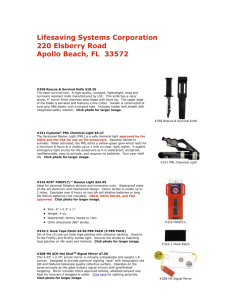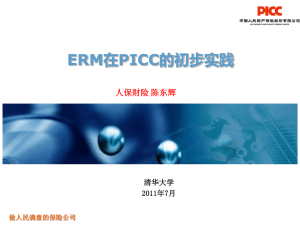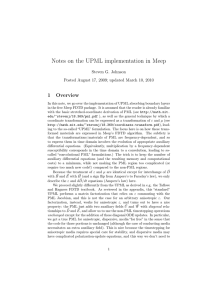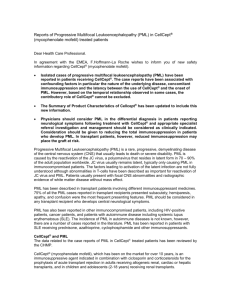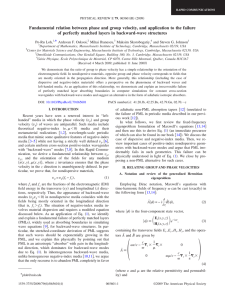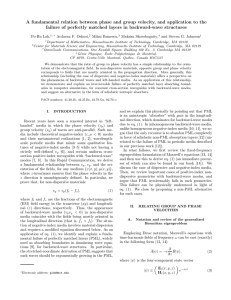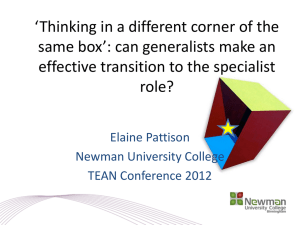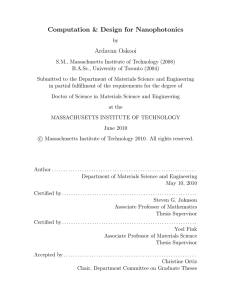Document 10499551
advertisement
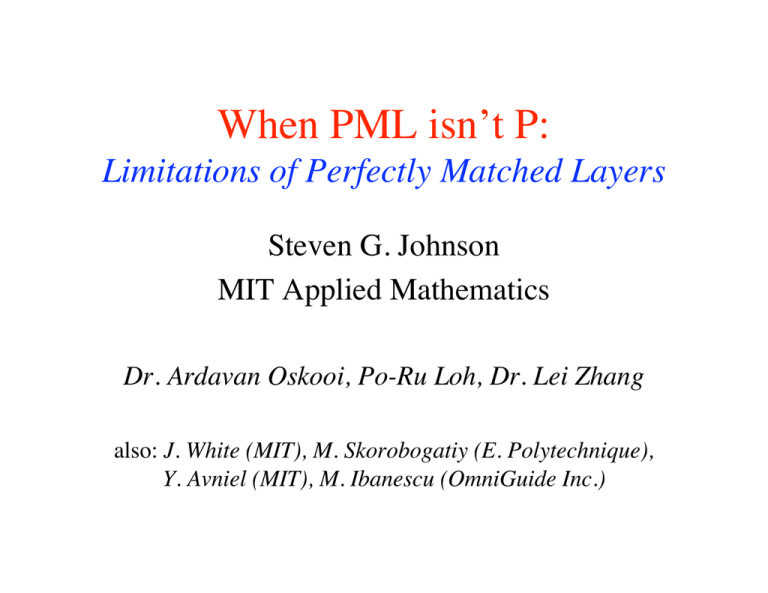
When PML isn’t P:
Limitations of Perfectly Matched Layers
Steven G. Johnson
MIT Applied Mathematics
Dr. Ardavan Oskooi, Po-Ru Loh, Dr. Lei Zhang
also: J. White (MIT), M. Skorobogatiy (E. Polytechnique),
Y. Avniel (MIT), M. Ibanescu (OmniGuide Inc.)
Why Absorbers?
Finite-difference/finite-element volume discretizations
need to artificially truncate space for a computer simulation.
In a wave equation,
a hard-wall truncation
gives reflection artifacts.
An old goal: absorbing
boundary
condition (ABC) that
absorbs outgoing waves.
Problem: good ABCs
are hard to find in > 1d.
Absorbing Boundary Layers?
…instead of absorbing boundary condition,
make an absorbing layer that attenuates waves…
Simplistic approach:
Just put some conductivity σ
around the boundaries?
Problem: reflections at
interface of absorbing region
Absorbing Boundary Layers?
…instead of absorbing boundary condition,
make an absorbing layer that attenuates waves…
Less simplistic approach:
Conductivity σ by boundaries
turns on gradually to reduce
reflections — e.g., quadratically
Better, but visible reflections
w/o very thick/gradual absorber
Perfectly Matched Layers (PMLs)
Bérenger, 1994: design an artificial absorbing layer
that is analytically reflectionless
Works remarkably well.
Now ubiquitous in FD/FEM
wave-equation solvers.
(Here, I’ll mainly discuss
the example of Maxwell’s eq.)
Perfectly Matched Layers (PMLs)
Bérenger, 1994: design an artificial absorbing layer
that is analytically reflectionless
Even works in inhomogeneous
media (e.g. waveguides).
Two questions:
• Review: How does PML work?
• When does PML not work?
Two questions:
• Review: How does PML work?
• When does PML not work?
Three equivalent approaches
• Bérenger (1994): design artificial equations ( split fields )
so that planewaves in vacuum are reflectionless
• Sacks et al. (1995): design artificial materials (anisotropic ε, µ)
so that planewaves in vacuum are reflectionless
• Chew & Weedon (1994): complex coordinate stretching so that waves in any(?) medium are attenuated.
… Ward & Pendry (1996): coordinate transformations are
equivalent to transformed/anisotropic ε, µ … leads back to artificial materials (Teixeira & Chew, 1998)
Starting point: A propagating wave
• Say we want to absorb wave traveling in +x direction
in an x-invariant medium at a frequency ω > 0.
fields ! f (y, z)e
i ( kx ! " t )
(usually, k > 0)
(only x in wave
equation is via
! / !x
terms.)
Step 1: Analytically continue
Fields (& wave equation terms) are analytic in x,
so we can evaluate at complex x & still solve same equations
i! ( x " )
!x(x) = x + $
dx "
#
i
!
x! = x +(allowx xdependent
"
x
unchanged
(no reflection)
PML strength σ)
unchanged
(no reflection)
fields ! f (y, z)e
i ( kx ! " t )
# f (y, z)e
k
i ( kx ! " t ) ! $ x
"
Step 2: Coordinate transformation
~
Weird to solve equations for complex coordinates x,
so do coordinate transformation back to real x.
x
x! (x) = x + $
%
(
* !
! 1 ! 2 '
1
"
"'
i# (x) * !x
!
!x
!x
'1 +
*
$ )
&
i! ( x " )
dx "
#
(allow x-dependent
PML strength σ)
fields ! f (y, z)e
i ( kx ! " t )
# f (y, z)e
i ( kx ! " t ) !
x
k
$ ( x % ) dx %
"
&
nondispersive materials: k/ω ~ constant
⇒ decay rate independent of ω
Step 3: Effective materials
In Maxwell s equations,! " E = i#µH, ! " H = $i#% E + J,
coordinate transformations are equivalent to transformed materials
(Ward & Pendry, 1996: “transformational optics”)
J{! , µ}J
{! , µ} "
det J
x PML Jacobian
$ (1 + i! / " )#1
'
&
)
J =&
1
)
&%
1 )(
" !x %
$# ! '&
!x
for isotropic starting materials:
T
effective
conductivity
& (1 + i# / $ )%1
(
{! , µ} " {! , µ} (
1 + i# / $
('
1 + i# / $
)
+
+
+*
PML = effective anisotropic “absorbing” ε, µ
PML Magic
& (1 + i# / $ )%1
(
{! , µ} " {! , µ} (
1 + i# / $
('
1 + i# / $
)
+
+
+*
sprinkle the “magic PML dust” onto your materials,
and they become absorbing without reflections…
x
yz variation
irrelevant(?)
PML
Two questions:
• Review: How does PML work?
• When does PML not work?
x-varying media
What happens if medium is varying in the x direction (i.e., ⊥ to PML)?
Who cares?
— If it s x-varying, surely propagating waves
scatter anyway … absorbers are irrelevant?
The magic of periodicity
coherent propagation: Bloch wave
Light in a periodic medium (= photonic crystal)
can propagate without scattering absorbing
layer?
A slight change? Shrink λ by 20%
an optical insulator (photonic bandgap)
light cannot penetrate the structure at this wavelength!
all of the scattering destructively interferes Photonic crystals: Periodic EM media
optical insulators ultra-bright LEDs
(luminus.com)
trapping/guiding
light in vacuum
[ Cregan (1999) ]
[ D. Norris, UMN (2001) ]
flat superlenses planar
waveguides
& cavities
[ Song (2005) ]
metamaterials
[ Luo (2003) ]
[ Smith (2004) ]
Photonic-crystal PML?
ε not even continuous
in x direction,
much less analytic!
x
Analytic continuation of Maxwell’s equations is hopeless
— no reason to think that PML technique should work
Photonic-crystal PMLs: Magic dust?
PML
[ Koshiba, Tsuji, & Sasaki (2001) ]
[ Kosmidou et al (2003) ]
… & several other authors …
Low reflections claimed
— is PML working?
Something suspicious: very thick absorbers.
Failure of Photonic-crystal “pseudo-PML”
[ Oskooi et al, Optics Express 16, 11376 (2008) ]
1d test case:
in uniform ε=1 medium,
PML reflection → 0
for exact wave equation
(pseudo-)
PML in
periodic ε
reflection
doesn’t → 0
as ∆x → 0
… similar
to non-PML
scalar σ
Redemption of the pseudo-PML:
slow (adiabatic) absorption turn-on
[ Oskooi et al, Optics Express 16, 11376 (2008) ]
Any absorber,
turned on gradually
enough, will have
reflections → 0!
PML (when it works)
just helps coefficient.
Understanding gradual change:
Coupled-wave theory
[ basic idea dates back to 1950s & earlier ]
L
x
expand fields in eigenmodes ψn of each cross-section:
x
fields(x) = & cn (x) ! n (y, z) e
n
%
"i# t +i kn ( x $ ) dx $
→ ODEs for
cn(x) [ non-trivial extension to periodic media: Johnson (2002) ]
Coupled-mode equations
L
• Rescale u = x/L
• Parameterize structure by s(u): [0,1] → [0,1]
u
dcm
M nm [s(u)] iL # "knm [ s(u ! )] du !
= % s!(u)
e
cn (u)
du n $ m
"knm [s(u)]
rate of
change
matrix
element
phase
mismatch
Limit of large L (gradual taper):
cn(u) → cn(0)
adiabatic theorem Lowest-order reflection
L
• Rescale u = x/L
• Parameterize structure by s(u): [0,1] → [0,1]
u
M nm [s(u)] iL # "knm [ s(u ! )] du !
creflected (L) = cincident # s!(u)
e
du
"knm [s(u)]
0
1
u
say ∆k real, definite-sign … change variables ! (u )
=
$ "knm [ s(u # )] du #
" (1)
creflected (L) = cincident
#
s!(u(" )) f (" )eiL" d "
0
Fourier transform! Convergence → 0 depends on smoothness of s'(u).
Back to absorption tapers
• Suppose absorption is: σ(x) = σ0 s(x/L), say s(u) = ud
1
• Fix the round-trip reflection: Rround-trip = e
! # L" 0
# s(u ) du
0
⇒ … ⇒ transition reflections ~ O(L–2d–2)
[ Oskooi et al, Optics Express 16, 11376 (2008) ]
1
$ "0 !
L
Reflection vs. Absorber Thickness
[ Oskooi et al, Optics Express 16, 11376 (2008) ]
s = u1
s = u2
s = u3
s = u4
s = u5
Adiabatic Absorbers: Parting Thoughts
• Turning on σ gradually is the backup plan when PML fails.
• Even real PML turns on σ gradually to mitigate discretization.
• Several reports of working PML in the literature
turn out to be just adiabaticity.
• As the absorber length L becomes longer, smoother σ is beneficial.
(exponential convergence is possible for C∞ functions σ … but hard to get good constant factor)
• Finding the best adiabatic σ is a difficult problem
— highly problem-dependent
— but desirable to avoid thick absorbers, especially in 3d
— min. L rapidly increase for slow-light (low vg) systems
[ Oskooi et al, Optics Express 16, 11376 (2008) ]
Two questions:
• Review: How does PML work?
• When does PML not work?
Starting point: A propagating wave
• Say we want to absorb wave traveling in +x direction
in an x-invariant medium at a frequency ω > 0.
fields ! f (y, z)e
i ( kx ! " t )
(usually, k > 0)
What if k < 0? i.e. vg = dω/dk > 0 and vp = ω/k < 0?
PML: fields ! f (y, z)e
i ( kx ! " t )
# f (y, z)e
i ( kx ! " t ) !
k
$x
"
Exponentially growing PML fields for σ > 0!!
Backward-Wave Modes?
vg = dω/dk > 0 and vp = ω/k < 0
(in x-invariant media)
• Impossible in homogeneous media with ε > 0, µ > 0
• Impossible in index-guided (total internal reflection)
waveguides with ε > 0
[ Bamberger & Bonnet (1990) ]
• Possible in left-handed media with ε < 0, µ < 0 for some ω
— just flip to σ < 0 in left-handed ω ranges
[ Cummer (2004); Dong et al. (2004) ]
• Possible in certain waveguides confined by
metals or photonic bandgaps…
Backward Waveguides
hollow metal tube with
inhomogenous core
ε1
photonic-crystal fibers
[ Clarricoats & Waldron (1960) ] ε2
metal
surface plasmons
of coated metal
[ Karalis et al.
(2009) ]
[ Ibanescu et al. (2004) ]
All have both signs of vg
at same ω — PML blows up
for any sign of σ.
k
[ Loh et al, (2009) ]
Failure of Backward-Wave PML
[ Loh et al, PRE Rapid Comm. 79, 065601 (2009) ]
k
k
How Can an Absorber Give Gain?
If PML is effectively an anisotropic absorbing material,
how can any field pattern yield exponential growth?
• Answer, part I: it s not exclusively absorbing.
& (1 + i# / $ )%1
(
{! , µ} " {! , µ} (
1 + i# / $
('
1 + i# / $
)
+
+
+*
Im < 0 ⇒ gain for longitudinal (x) components
• Answer, part II: backward waves = mostly longitudinal fields
a little-known identity:
vg = vp
transverse
field energy
longitudinal
field energy
total field energy
[ Loh et al.
(2009) ]
For Those of You Feeling Smug
Surface integral-equation methods
(e.g. BEM) only discretize interfaces
and treat ∞ space analytically
— no need for PML!
… unless one has surfaces extending to ∞ …
waveguide input/output
… e.g. waveguide bend…
worse, photonic crystals…
Truncating Integral Equations
[ Lei Zhang, J. Lee, A. Oskooi, A. Hochman, J. White, S. G. Johnson (2010) ]
• want an adiabatic absorber truncation — turned on gradually
• must use homogeneous materials for BEM efficiency
⇒ use an adiabatic surface conductivity
(δ-function σ = jump condition at interface)
~ 10–8 reflection with L=10λ
finis
PML is a wonderful tool, but not a panacea.
One fallback is an adiabatic absorber,
but current situation here is still suboptimal.
Photonic Crystals book: http://jdj.mit.edu/book
Papers/preprints: http://math.mit.edu/~stevenj
PML notes: http://math.mit.edu/~stevenj/notes
